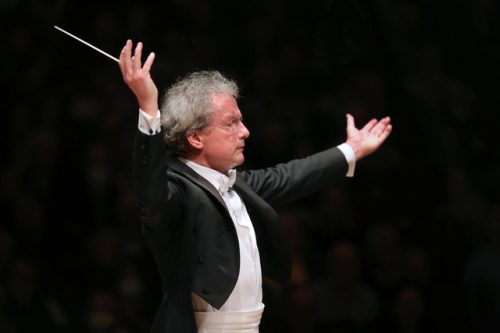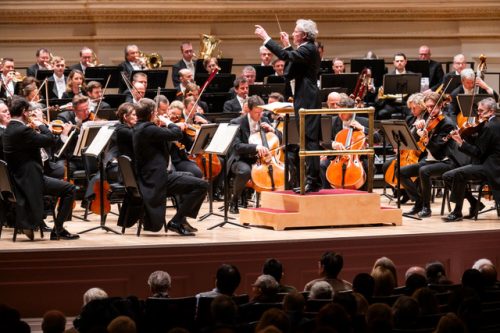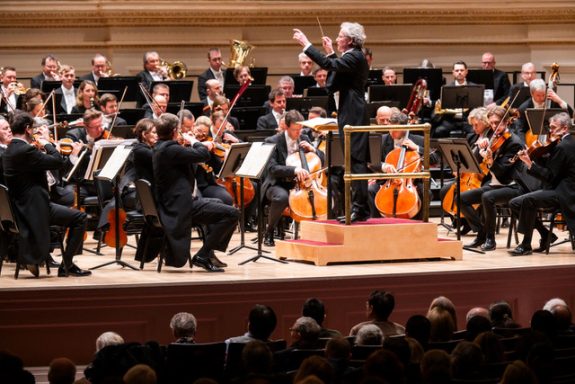 United States Various: Vienna Philharmonic Orchestra / Franz Welser-Möst (conductor). Carnegie Hall, New York, 2.3.2024. (RP)
United States Various: Vienna Philharmonic Orchestra / Franz Welser-Möst (conductor). Carnegie Hall, New York, 2.3.2024. (RP)

Hindemith – Konzertmusik für Blasorchester, Op.41
R, Strauss – Symphonic Fantasy from Die Frau ohne Schatten
Schoenberg – Variations for Orchestra, Op.31
Ravel – La valse
Franz Welser-Möst led the Vienna Philharmonic Orchestra in three concerts in as many days this past weekend at Carnegie Hall. Sandwiched between the ninth symphonies of Bruckner and Mahler was this eclectic concert of works by composers active between the great wars of the first half of the twentieth century. In Germany, this era is known as the Weimar Republic.
Carnegie Hall has made the cultural milieu of the Weimar Republic the centerpiece of its current season. Links between the era and some of the music programmed are tangential at best, but this one hit the bullseye. It also saw both conductor and orchestra in peak form in a concert of works as diverse, exciting and challenging as the era itself.
Paul Hindemith and Richard Strauss had complex and paradoxical relationships with the Nazi Party. Joseph Goebbels, chief propagandist for the Nazi Party, recognized Hindemith as ‘one of the most important talents in the younger generation of composers’. His halo would slip, however, as the Nazis tightened their grip on German society. Hindemith and his wife, Gertrude, who was of Jewish descent, left Germany for Switzerland in 1938, before immigrating to the United States two years later.
Although Hindemith was one of the most prominent composers of the day, his style poses challenges for a contemporary audience. Stylistically, he was rooted in the past, particularly the Baroque and Classical eras, but harmonically he was in sync with the avant-garde, especially in his use of derivative scale techniques. In some ways, his music sounds like hyper-Teutonic Stravinsky in his neoclassical mode.
Hindemith composed Konzertmusik für Blasorchester in 1926 for a German-style military band of woodwinds, brass and percussion, a combination of instruments that supposedly has a mellower sound than the average concert band which has more brass and fewer woodwinds. Mellow didn’t particularly spring to mind in this wonderfully raucous and precise performance of the work. It was, however, boisterous within prescribed limits. with Welser-Möst lending his usual precision and attention to detail to the piece.
Richard Strauss reached a personal and political accommodation with the Third Reich, although it came at a cost. He was exonerated after the war at his denazification trial, but still faced condemnation by contemporaries. Strauss was able to shield his daughter-in-law, Alice, who was Jewish, from being sent to a concentration camp, but his efforts to rescue members of her family came to naught.
The opera Die Frau ohne Schatten was one of the fruits of Strauss’s remarkable collaboration with Hugo von Hofmannsthal. Premiering in 1919, the opera has a complex plot, a colorful score and requires enormous resources to stage. After World War II, Strauss culled the ‘best parts’ of the opera’s score to create an orchestral work very similar to the far more popular Der Rosenkavalier Suite, which Strauss did not arrange but condoned as he needed the money.

Welser-Möst has championed Strauss’s operas in both staged and concert performances in Vienna and Cleveland, where he serves as music director of its fabled orchestra. His affinity with the composer’s style was apparent from the start, as was that of the orchestra. The performance had all the melodic sweep to be expected, with glittering, scintillating sounds in the music extracted from the scene in the opera where the Nurse tries to coax the Dyer’s Wife to sell her shadow.
An especially engaging passage was the solo trombone taking the Dyer’s vocal part in a duet that he has with his wife in the opera. A stunning musical apotheosis crowned the final moments of the performance, reflecting the transformation that the merely human husband and wife and an equally flawed couple from a magical realm have undergone.
Prior to the rise of the Nazis, Arnold Schoenberg, who was Jewish, prided himself as being the ‘chosen one’ who would carry the torch of German music into the twentieth century. Such sentiments mattered little to the Nazis, whose denunciations of both the man and his music forced Schoenberg to immigrate to the US in 1933.
Schoenberg’s Variations for Orchestra is one of the most demanding works ever composed for a large symphony orchestra. The players of the Berlin Philharmonic baulked at both Schoenberg’s style and the work’s technical challenges when they played its first performance in 1928. Hissed at by the audience and dismissed by the critics for being ‘soulless arithmetic music’, the premiere was a fiasco.
Welser-Möst leaned into the post-Romantic expressiveness of the opening measure where the theme is first announced. The passages that found Schoenberg at his most dense and complicated, however, found the conductor at his best. Welser-Möst went beyond precision to extract lyricism and emotion from the orchestra, even when the music was at its most angular.
The final work on the program was Ravel’s La valse, which he completed in 1920. Originally intended as ballet music, it is most often performed as a concert work. The piece is inspired by the Viennese obsession for the waltz, with the ballet being set in an imperial court in 1855. Many have interpreted the work to be a commentary on the state of European society and culture after the First World War, but Ravel dismissed any such notions.
La valse has been described as one long crescendo culminating in a violent, explosive release, which was exactly Welser-Möst’s approach to the work. He led a performance that was a feast of orchestral color in three-quarter time, ranging from muted cello and double basses playing tremolos to a gorgeous, sweeping waltz after which chaos reigned. The latter, of course, was always controlled by Welser-Möst’s scrupulous attention to detail and pace.
The finale and its five thunderous unisons from the full orchestra brought the piece to a dramatic climax and the capacity audience instantly to its feet.
Rick Perdian

A great concert, an excellent review with one caveat-the Hindemith. But other than that work (I normally admire if not love the composer) this concert was one of the few times I have enjoyed the playing of the Vienna and Welser-Most’s conducting. He and the orchestra were obviously extremely sympatico that night.